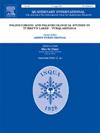Holocene paleoclimatic records from Chakrata area, Northwest Himalaya
IF 1.9
3区 地球科学
Q3 GEOGRAPHY, PHYSICAL
引用次数: 0
Abstract
We present monsoon variability records for the Holocene using multi-proxy approach (environmental magnetism, carbon isotope, and total organic carbon) from a 146 cm thick sedimentary profile in the Kotikanasar meadow (Chakrata), Northwest Himalaya. The chronology of the record was constrained by five AMS 14C ages. The carbon isotope (δ13C) and Total Organic Carbon (TOC) data highly variable which vary between −26.62‰ and −22.46‰ (C3-plants) and 0.1–∼4%, respectively, indicating paleo-vegetation history and productivity of the studied area. The environmental magnetism is highly fluctuating in the Early Holocene with high concentrations of magnetic minerals during the high monsoon conditions and vice-versa. Intense Indian Summer Monsoon (ISM) phases were identified during the Early and Late Holocene i.e., ∼9.2 to 7.4 ka, and ∼4.8 ka to Modern which shows warm and wet climate. While decline in the ISM intensity during ∼7.4 to 4.8 ka which indicates cold and dry climatic condition in the Northwest Himalayan regions. From ∼9.2 to 7.4 ka, highly fluctuating climate linked with the Early Holocene warming. Sediment profile exhibits aridity in climate accompanying with the high influence of mid-latitude westerlies during ∼7.4 to 4.8 ka from Northwest Indian regions. Hence the long-term fluctuation in the climate governed by the changes in the North Atlantic Ocean circulation as well as variations in the incoming solar radiations.
喜马拉雅西北部 Chakrata 地区全新世古气候记录
我们采用多代理方法(环境磁性、碳同位素和总有机碳),从喜马拉雅山西北部科蒂卡纳萨草甸(Chakrata)厚达 146 厘米的沉积剖面中获得了全新世季风变化记录。该记录的年代学受五个 AMS 14C 年龄的限制。碳同位素(δ13C)和总有机碳(TOC)数据变化很大,分别介于-26.62‰和-22.46‰(C3-植物)和 0.1-4%之间,表明了研究区域的古植被历史和生产力。全新世早期的环境磁性波动很大,季风强时磁性矿物浓度高,反之亦然。在全新世早期和晚期,即 9.2 至 7.4 ka,以及 4.8 ka 至现代,发现了强烈的印度夏季季风(ISM)阶段,这表明气候温暖湿润。而在 7.4 至 4.8 ka 期间,ISM 强度下降,表明喜马拉雅西北地区气候寒冷干燥。9.2 ∼ 7.4 ka期间,气候剧烈波动,与全新世早期气候变暖有关。沉积物剖面显示,在 7.4 ka ∼ 4.8 ka 期间,印度西北部地区受中纬度西风影响较大,气候干旱。因此,气候的长期波动受北大西洋环流变化和太阳辐射入射变化的影响。
本文章由计算机程序翻译,如有差异,请以英文原文为准。
求助全文
约1分钟内获得全文
求助全文
来源期刊

Quaternary International
地学-地球科学综合
CiteScore
5.60
自引率
4.50%
发文量
336
审稿时长
3 months
期刊介绍:
Quaternary International is the official journal of the International Union for Quaternary Research. The objectives are to publish a high quality scientific journal under the auspices of the premier Quaternary association that reflects the interdisciplinary nature of INQUA and records recent advances in Quaternary science that appeal to a wide audience.
This series will encompass all the full spectrum of the physical and natural sciences that are commonly employed in solving Quaternary problems. The policy is to publish peer refereed collected research papers from symposia, workshops and meetings sponsored by INQUA. In addition, other organizations may request publication of their collected works pertaining to the Quaternary.
 求助内容:
求助内容: 应助结果提醒方式:
应助结果提醒方式:


